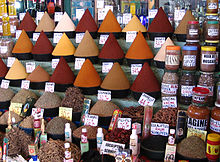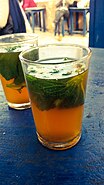..
Moroccan cuisine
Location of Morocco
Ingredients
Morocco produces a large range of Mediterranean fruits and vegetables and even some tropical ones. Common meats include beef, goat, mutton and lamb, chicken and seafood, which serve as a base for the cuisine. Characteristic flavorings include lemon pickle, argan oil, cold-pressed, unrefined olive oil and dried fruits.[2] As in Mediterranean cuisine in general, the staple ingredients include wheat, used for bread and couscous, and olive oil; the third Mediterranean staple, the grape, is eaten as a dessert, though a certain amount of wine is made in the country.[3][4]Flavorings
Spices at central market in Agadir
Common herbs in Moroccan cuisine include naanaa (mint), maadnous (parsley), quesbour (coriander), fliyo (peppermint), merdedouch (marjoram), kerouiya (caraway), ellouiza (verbena) and "salmia" (sage).
Structure of meals
A typical lunch meal begins with a series of hot and cold salads, followed by a tagine or Dwaz. Often, for a formal meal, a lamb or chicken dish is next, or couscous topped with meat and vegetables. Moroccans either eat with fork, knife and spoon or with their hands using bread as a utensil depending on the dish served. The consumption of pork and alcohol is not common due to religious restrictions.[6]Main dishes
The main Moroccan dish most people are familiar with is couscous,[7] the old national delicacy. Beef is the most commonly eaten red meat in Morocco, usually eaten in a tagine with a wide selection of vegetables. Chicken is also very commonly used in tagines, or roasted.Lamb is also heavily consumed, and since Moroccan sheep breeds store most of their fat in their tails, Moroccan lamb does not have the pungent flavour that Western lamb and mutton have.[citation needed]
Since Morocco lies on two coasts, the Atlantic and the Mediterranean, Moroccan cuisine has ample seafood dishes. European pilchard is caught in large but declining quantities.[8] Other fish species include mackerel, anchovy, sardinella, and horse mackerel.[9]
Other famous Moroccan dishes are Pastilla (also spelled Basteeya or Bestilla), Tanjia and Harira, a typical heavy soup, eaten during winter to warm up and is usually served for dinner, it is typical eaten with plain bread or with dates during the month of Ramadan. Bissara is a broad bean-based soup that is also consumed during the colder months of the year.[10]
A big part of the daily meal is bread. Bread in Morocco is principally made from durum wheat semolina known as khobz. Bakeries are very common throughout Morocco and fresh bread is a staple in every city, town and village. The most common is whole grain coarse ground or white flour bread or baguettes. There are also a number of flat breads and pulled unleavened pan-fried breads.
In addition, there are dried salted meats and salted preserved meats such as kliia/khlia[11] and g'did, which are used to flavor tagines or used in "el ghraif", a folded savory Moroccan pancake.
Salads
Salad asorti, served in Beni Mellal
Desserts
Usually, seasonal fruits rather than cooked desserts are served at the close of a meal. A common dessert is kaab el ghzal ("gazelle's horns"), a pastry stuffed with almond paste and topped with sugar. Another is "Halwa chebakia", pretzel-shaped dough deep-fried, soaked in honey and sprinkled with sesame seeds; it is eaten during the month of Ramadan. Coconut fudge cakes, 'Zucre Coco', are popular also.Seafood
Morocco is fortunate to have over 3000 km of coast line. There is an abundance of fish in these coastal waters with the sardine being commercially significant as Morocco is the world's largest exporter.[13] At Moroccan fish markets one can find, sole, swordfish, tuna, tarbot, mackerel, shrimp, congre eel, skate, red snapper, spider crab, lobster and a variety of mollusks.
Assorted seafood in Morocco at the Marché Central in Casablanca
Drinks
The most popular drink is green tea with mint. Traditionally, making good mint tea in Morocco is considered an art form and the drinking of it with friends and family is often a daily tradition. The pouring technique is as crucial as the quality of the tea itself. Moroccan tea pots have long, curved pouring spouts and this allows the tea to be poured evenly into tiny glasses from a height. For the best taste, glasses are filled in two stages. The Moroccans traditionally like tea with bubbles, so while pouring they hold the teapot high above the glasses. Finally, the tea is accompanied with hard sugar cones or lumps.[14] Morocco has an abundance of oranges and tangerines, so fresh orange juice is easily found freshly squeezed and is cheap.
Mint tea
Snacks and fast food
A food stall in the Djemaa el Fna
Dairy product shops locally called Mhlaba, are very prevalent all around the country. Those dairy stores generally offer all types of dairy products, juices, and local delicacies such as (Bocadillos, Msemen and Harcha).[16]
In the late 1990s, several multinational fast-food franchises opened restaurants in major cities.[17]
Moroccan food abroad
Moroccan cuisine has influenced the cuisine of Algeria, specially that of the towns near the Moroccan border in the west[18].Couscous is one of the most popular North African dishes globally. Markets, stores and restaurants in Europe, especially in France and lately the United Kingdom, feature lamb tajine, bastilla, and couscous.
Paula Wolfert, prolific American author of nine cookbooks (two on Moroccan cuisine), helped enable Moroccan-Americans to enjoy their native cuisine with ease. Couscous and Other Good Food from Morocco was published in 1973 and is still in print; it was added to the James Beard Hall of Fame in 2008. Her Food of Morocco came out in 2011 and won the 2012 James Beard Award for Best International Cookbook.[19] Wolfert appeared on the Martha Stewart Show to demonstrate cooking in clay.
Raised between Fez and San Sebastian, chef Najat Kaanache has served as an unofficial culinary ambassador of Morocco, sharing Moroccan flavors and cooking techniques with many of the world's top chefs during her pilgrimage through the best restaurant kitchens of Spain, Denmark, the Netherlands and the US.[20]https://en.wikipedia.org/wiki/Moroccan_cuisine







EmoticonEmoticon